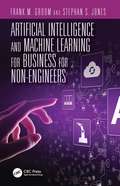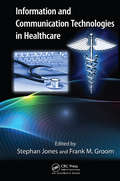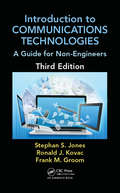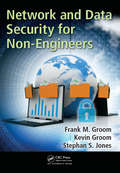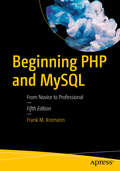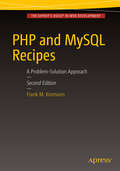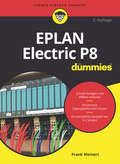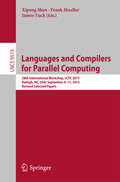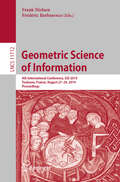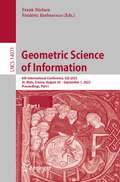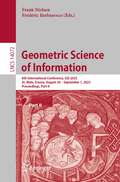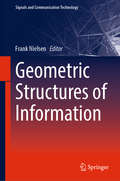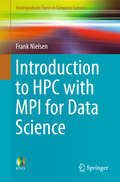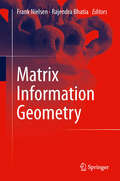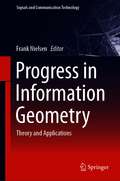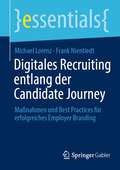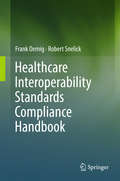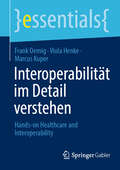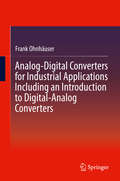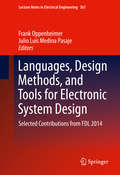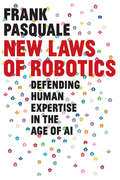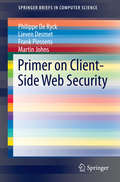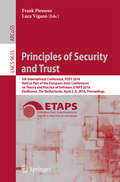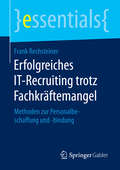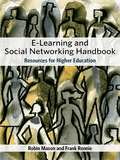- Table View
- List View
Artificial Intelligence and Machine Learning for Business for Non-Engineers (Technology for Non-Engineers)
by Frank M. Groom Stephan S. JonesThe next big area within the information and communication technology field is Artificial Intelligence (AI). The industry is moving to automate networks, cloud-based systems (e.g., Salesforce), databases (e.g., Oracle), AWS machine learning (e.g., Amazon Lex), and creating infrastructure that has the ability to adapt in real-time to changes and learn what to anticipate in the future. It is an area of technology that is coming faster and penetrating more areas of business than any other in our history. AI will be used from the C-suite to the distribution warehouse floor. Replete with case studies, this book provides a working knowledge of AI’s current and future capabilities and the impact it will have on every business. It covers everything from healthcare to warehousing, banking, finance and education. It is essential reading for anyone involved in industry.
Information and Communication Technologies in Healthcare (Technology For Non-engineers Ser.)
by Stephan Jones Frank M. GroomAs the population ages and healthcare costs continue to soar, the focus of the nation and the healthcare industry turns to reducing costs and making the delivery process more efficient. Demonstrating how improvements in information systems can lead to improved patient care, Information and Communication Technologies in Healthcare explains how to cr
Introduction to Communications Technologies: A Guide for Non-Engineers, Third Edition
by Stephan Jones Ronald J. Kovac Frank M. GroomThanks to the advancement of faster processors within communication devices, there has been a rapid change in how information is modulated, multiplexed, managed, and moved. While formulas and functions are critical in creating the granular components and operations of individual technologies, understanding the applications and their purposes in the
Network and Data Security for Non-Engineers (Technology for Non-Engineers)
by Frank M. Groom Stephan S. Jones Kevin GroomLearn network and data security by analyzing the Anthem breach and step-by-step how hackers gain entry, place hidden software, download information, and hide the evidence of their entry. Understand the tools, establishing persistent presence, use of sites as testbeds to determine successful variations of software that elude detection, and reaching out across trusted connections to the entire healthcare system of the nation. Examine the components of technology being diverted, starting with application code and how to protect it with isolation approaches. Dissect forms of infections including viruses, worms, bots, and Trojans; and encryption with RSA algorithm as the working example.
Beginning PHP and MySQL: From Novice to Professional
by Frank M. KromannGet started with PHP and MySQL programming: no experience necessary. This fifth edition of a classic best-seller includes detailed instructions for configuring the ultimate PHP 7 and MySQL development environment on all major platforms, complete coverage of the latest additions and improvements to the PHP language, and thorough introductions to MySQL’s most relied-upon features. You'll not only receive extensive introductions to the core features of PHP, MySQL, and related tools, but you'll also learn how to effectively integrate them in order to build robust data-driven applications. Author Frank M. Kromann draws upon more than 20 years of experience working with these technologies to pack this book with practical examples and insight into the real-world challenges faced by developers. Accordingly, you will repeatedly return to this book as both a valuable instructional tool and reference guide. What You Will LearnInstall PHP, MySQL, and several popular web serversGet started with PHP, including using its string-handling, networking, forms-processing, and object-oriented featuresGain skills in MySQL’s fundamental features, including supported data types, database management syntax, triggers, views, stored routine syntax, and import/export capabilitiesWork with hundreds of examples demonstrating countless facets of PHP and MySQL integrationWho This Book Is ForAnyone who wants to get started using PHP to write dynamic web applications.
PHP and MySQL Recipes
by Frank M. KromannThis book is a source of instant solutions, including countless pieces of useful code that you can copy and paste into your own applications, giving you answers fast and saving you hours of coding time. You can also use this book as a reference to the most important aspects of the latest PHP scripting language, including the vital functions you know and love from previous versions of PHP, as well as the functions introduced in PHP 7. PHP and MySQL Recipes: A Problem-Solution Approach supplies you with complete code for all of the common coding problems you are likely to face when using PHP and MySQL together in your day-to-day web application development. This invaluable guide includes over 200 recipes and covers numerous topics. What you hold in your hands is the answer to all your PHP 7 needs. Furthermore, this book explains the PHP functionality in detail, including the vastly improved object-oriented capabilities and the new MySQL database extension. PHP and MySQL Recipes will be a useful and welcome companion throughout your career as a web developer, keeping you on the cutting edge of PHP development, ahead of the competition, and giving you all the answers you need, when you need them. What you'll learn How to work with arrays, dates and times, strings, files and directories, and dynamic imaging How to write regular expressions in PHP How to use the variables and functions found in PHP How to do web development using PHP, including the creation of forms How to use MySQL databases using phpMyAdmin and other tools and clients How to use MySQL stored routines, PDOs, triggers, views, database queries, transactions, indexes and searching Who this book is for This reference is for experienced PHP and MySQL programmers and web developers who have at least some PHP and MySQL programming experience.
EPLAN Electric P8 für Dummies (Für Dummies)
by Frank MeinertSie arbeiten mit EPLAN Electric P8 und wollen wissen, wie Sie Schaltpläne ohne Umwege zeichnen und umfassend auswerten? Hinsetzen, Buch aufschlagen, Kapitel für Kapitel durcharbeiten, fertigen Schaltplan haben! Dieses Buch ermöglicht Ihnen einen schnellen und effektiven Einstieg in EPLAN Electric P8 und enthält die besten Tricks für den Umgang mit dem Programm. Anhand eines Beispielprojekts werden Sie Schritt für Schritt an das Programm herangeführt. Und die Beispieldateien werden auch noch zum Download angeboten. So können Sie sehr schnell gewinnbringend arbeiten.
Languages and Compilers for Parallel Computing
by Xipeng Shen Frank Mueller James TuckThisbook constitutes the thoroughly refereed post-conference proceedings of the 28thInternational Workshop on Languages and Compilers for Parallel Computing, LCPC2015, held in Raleigh, NC, USA, in September 2015. The19 revised full papers were carefully reviewed and selected from 44 submissions. The papers are organized in topical sections on programming models, optimizingframework, parallelizing compiler, communication and locality, parallelapplications and data structures, and correctness and reliability.
Geometric Science of Information: 4th International Conference, GSI 2019, Toulouse, France, August 27–29, 2019, Proceedings (Lecture Notes in Computer Science #11712)
by Frank Nielsen Frédéric BarbarescoThis book constitutes the proceedings of the 4th International Conference on Geometric Science of Information, GSI 2019, held in Toulouse, France, in August 2019.The 79 full papers presented in this volume were carefully reviewed and selected from 105 submissions. They cover all the main topics and highlights in the domain of geometric science of information, including information geometry manifolds of structured data/information and their advanced applications.
Geometric Science of Information: 6th International Conference, GSI 2023, St. Malo, France, August 30 – September 1, 2023, Proceedings, Part I (Lecture Notes in Computer Science #14071)
by Frank Nielsen Frédéric BarbarescoThis book constitutes the proceedings of the 6th International Conference on Geometric Science of Information, GSI 2023, held in St. Malo, France, during August 30-September 1, 2023. The 125 full papers presented in this volume were carefully reviewed and selected from 161 submissions. They cover all the main topics and highlights in the domain of geometric science of information, including information geometry manifolds of structured data/information and their advanced applications. The papers are organized in the following topics: geometry and machine learning; divergences and computational information geometry; statistics, topology and shape spaces; geometry and mechanics; geometry, learning dynamics and thermodynamics; quantum information geometry; geometry and biological structures; geometry and applications.
Geometric Science of Information: 6th International Conference, GSI 2023, St. Malo, France, August 30 – September 1, 2023, Proceedings, Part II (Lecture Notes in Computer Science #14072)
by Frank Nielsen Frédéric BarbarescoThis book constitutes the proceedings of the 6th International Conference on Geometric Science of Information, GSI 2023, held in St. Malo, France, during August 30-September 1, 2023. The 125 full papers presented in this volume were carefully reviewed and selected from 161 submissions. They cover all the main topics and highlights in the domain of geometric science of information, including information geometry manifolds of structured data/information and their advanced applications. The papers are organized in the following topics: geometry and machine learning; divergences and computational information geometry; statistics, topology and shape spaces; geometry and mechanics; geometry, learning dynamics and thermodynamics; quantum information geometry; geometry and biological structures; geometry and applications.
Geometric Structures of Information (Signals and Communication Technology)
by Frank NielsenThis book focuses on information geometry manifolds of structured data/information and their advanced applications featuring new and fruitful interactions between several branches of science: information science, mathematics and physics. It addresses interrelations between different mathematical domains like shape spaces, probability/optimization & algorithms on manifolds, relational and discrete metric spaces, computational and Hessian information geometry, algebraic/infinite dimensional/Banach information manifolds, divergence geometry, tensor-valued morphology, optimal transport theory, manifold & topology learning, and applications like geometries of audio-processing, inverse problems and signal processing. The book collects the most important contributions to the conference GSI’2017 – Geometric Science of Information.
Introduction to HPC with MPI for Data Science
by Frank NielsenThis gentle introduction to High Performance Computing (HPC) for Data Science using the Message Passing Interface (MPI) standard has been designed as a first course for undergraduates on parallel programming on distributed memory models, and requires only basic programming notions. Divided into two parts the first part covers high performance computing using C++ with the Message Passing Interface (MPI) standard followed by a second part providing high-performance data analytics on computer clusters. In the first part, the fundamental notions of blocking versus non-blocking point-to-point communications, global communications (like broadcast or scatter) and collaborative computations (reduce), with Amdalh and Gustafson speed-up laws are described before addressing parallel sorting and parallel linear algebra on computer clusters. The common ring, torus and hypercube topologies of clusters are then explained and global communication procedures on these topologies are studied. This first part closes with the MapReduce (MR) model of computation well-suited to processing big data using the MPI framework. In the second part, the book focuses on high-performance data analytics. Flat and hierarchical clustering algorithms are introduced for data exploration along with how to program these algorithms on computer clusters, followed by machine learning classification, and an introduction to graph analytics. This part closes with a concise introduction to data core-sets that let big data problems be amenable to tiny data problems. Exercises are included at the end of each chapter in order for students to practice the concepts learned, and a final section contains an overall exam which allows them to evaluate how well they have assimilated the material covered in the book.
Matrix Information Geometry
by Rajendra Bhatia Frank NielsenThis book presents advances in matrix and tensor data processing in the domain of signal, image and information processing. The theoretical mathematical approaches are discusses in the context of potential applications in sensor and cognitive systems engineering. The topics and application include Information Geometry, Differential Geometry of structured Matrix, Positive Definite Matrix, Covariance Matrix, Sensors (Electromagnetic Fields, Acoustic sensors) and Applications in Cognitive systems, in particular Data Mining.
Progress in Information Geometry: Theory and Applications (Signals and Communication Technology)
by Frank NielsenThis book focuses on information-geometric manifolds of structured data and models and related applied mathematics. It features new and fruitful interactions between several branches of science: Advanced Signal/Image/Video Processing, Complex Data Modeling and Analysis, Statistics on Manifolds, Topology/Machine/Deep Learning and Artificial Intelligence. The selection of applications makes the book a substantial information source, not only for academic scientist but it is also highly relevant for industry. The book project was initiated following discussions at the international conference GSI’2019 – Geometric Science of Information that was held at ENAC, Toulouse (France).
Digitales Recruiting entlang der Candidate Journey: Maßnahmen und Best Practices für erfolgreiches Employer Branding (essentials)
by Michael Lorenz Frank NientiedtEmployer Branding und Social Recruiting werden in Zeiten des Fachkräftemangels zu einem zentralen Bestandteil der HR-Arbeit eines jeden Unternehmens. In diesem Essential stellen die Autoren Michael Lorenz und Frank Nientiedt relevante Kanäle und Maßnahmen für die ersten drei Candidate-Journey-Phasen (Anziehung, Information und Bewerbung) vor. Zahlreiche Praxistipps und sechs aktuelle Best Practices aus unterschiedlichen Branchen geben Anregungen für eine einfache Umsetzung im eigenen Unternehmen. Es zeigt sich: Eine positive Candidate Experience wird durch authentische Inhalte und mutige Ideen erzeugt, angepasst an die jeweiligen Zielgruppen. Gerade die jüngere Zielgruppe wird durch Kanäle wie TikTok, WhatsApp und Instagram erreicht. Zum Abschluss gibt HR-Experte Tim Verhoeven anhand von fünf Thesen einen Ausblick auf künftige Trends und die Auswirkungen des Arbeitskräftemangels und Beschleunigung der Digitalisierung.
Healthcare Interoperability Standards Compliance Handbook
by Frank Oemig Robert SnelickThis book focuses on the development and use of interoperability standards related to healthcare information technology (HIT) and provides in-depth discussion of the associated essential aspects. The book explains the principles of conformance, examining how to improve the content of healthcare data exchange standards (including HL7 v2. x, V3/CDA, FHIR, CTS2, DICOM, EDIFACT, and ebXML), the rigor of conformance testing, and the interoperability capabilities of healthcare applications for the benefit of healthcare professionals who use HIT, developers of HIT applications, and healthcare consumers who aspire to be recipients of safe and effective health services facilitated through meaningful use of well-designed HIT. Readers will understand the common terms interoperability, conformance, compliance and compatibility, and be prepared to design and implement their own complex interoperable healthcare information system. Chapters address the practical aspects of the subject matter to enable application of previously theoretical concepts. The book provides real-world, concrete examples to explain how to apply the information, and includes many diagrams to illustrate relationships of entities and concepts described in the text. Designed for professionals and practitioners, this book is appropriate for implementers and developers of HIT, technical staff of information technology vendors participating in the development of standards and profiling initiatives, informatics professionals who design conformance testing tools, staff of information technology departments in healthcare institutions, and experts involved in standards development. Healthcare providers and leadership of provider organizations seeking a better understanding of conformance, interoperability, and IT certification processes will benefit from this book, as will students studying healthcare information technology.
Interoperabilität im Detail verstehen: Hands-on Healthcare & Interoperability (essentials)
by Frank Oemig Viola Henke Marcus KuperDieses essential bietet einen Einstieg in die Fragestellung, was mit dem Begriff „Interoperabilität“ gemeint ist, der nicht nur den Datenaustausch zwischen IT-Systemen im Gesundheitswesen beschreibt. Dazu werden die in diesem Kontext häufig gebrauchten Begriffe wie Kompatibilität oder Konformität erläutert und in einen Zusammenhang gebracht. Weiterhin wird aufgezeigt, dass Interoperabilität das Ergebnis eines längeren Arbeits- und Austauschprozesses ist und wie „Interoperabilität“ für den erfolgreichen und reibungslosen Einsatz im Gesundheitssystem gemeinsam mit allen Stakeholdern weiterentwickelt werden kann.
Analog-Digital Converters for Industrial Applications Including an Introduction to Digital-Analog Converters
by Frank OhnhäuserThis book offers students and those new to the topic of analog-to-digital converters (ADCs) a broad introduction, before going into details of the state-of-the-art design techniques for SAR and DS converters, including the latest research topics, which are valuable for IC design engineers as well as users of ADCs in applications. The book then addresses important topics, such as correct connectivity of ADCs in an application, the verification, characterization and testing of ADCs that ensure high-quality end products. Analog-to-digital converters are the central element in any data processing system and regulation loops such as modems or electrical motor drives. They significantly affect the performance and resolution of a system or end product. System development engineers need to be familiar with the performance parameters of the converters and understand the advantages and disadvantages of the various architectures. Integrated circuit development engineers have to overcome the problem of achieving high performance and resolution with the lowest possible power dissipation, while the digital circuitry generates distortion in supply, ground and substrate. This book explains the connections and gives suggestions for obtaining the highest possible resolution. Novel trends are illustrated in the design of analog-to-digital converters based on successive approximation and the difficulties in the development of continuous-time delta-sigma modulators are also discussed.
Languages, Design Methods, and Tools for Electronic System Design
by Frank Oppenheimer Julio Luis Medina PasajeThis book brings together a selection of the best papers from the seventeenth edition of the Forum on specification and Design Languages Conference (FDL), which took place on October 14-16, 2014, in Munich, Germany. FDL is a well-established international forum devoted to dissemination of research results, practical experiences and new ideas in the application of specification, design and verification languages to the design, modeling and verification of integrated circuits, complex hardware/software embedded systems, and mixed-technology systems.
New Laws of Robotics: Defending Human Expertise In The Age Of Ai
by Frank PasqualeAI is poised to disrupt our work and our lives. We can harness these technologies rather than fall captive to them—but only through wise regulation.Too many CEOs tell a simple story about the future of work: if a machine can do what you do, your job will be automated. They envision everyone from doctors to soldiers rendered superfluous by ever-more-powerful AI. They offer stark alternatives: make robots or be replaced by them.Another story is possible. In virtually every walk of life, robotic systems can make labor more valuable, not less. Frank Pasquale tells the story of nurses, teachers, designers, and others who partner with technologists, rather than meekly serving as data sources for their computerized replacements. This cooperation reveals the kind of technological advance that could bring us all better health care, education, and more, while maintaining meaningful work. These partnerships also show how law and regulation can promote prosperity for all, rather than a zero-sum race of humans against machines.How far should AI be entrusted to assume tasks once performed by humans? What is gained and lost when it does? What is the optimal mix of robotic and human interaction? New Laws of Robotics makes the case that policymakers must not allow corporations or engineers to answer these questions alone. The kind of automation we get—and who it benefits—will depend on myriad small decisions about how to develop AI. Pasquale proposes ways to democratize that decision making, rather than centralize it in unaccountable firms. Sober yet optimistic, New Laws of Robotics offers an inspiring vision of technological progress, in which human capacities and expertise are the irreplaceable center of an inclusive economy.
Primer on Client-Side Web Security
by Philippe De Ryck Lieven Desmet Frank Piessens Martin JohnsThis volume illustrates the continuous arms race between attackers and defenders of the Web ecosystem by discussing a wide variety of attacks. In the first part of the book, the foundation of the Web ecosystem is briefly recapped and discussed. Based on this model, the assets of the Web ecosystem are identified, and the set of capabilities an attacker may have are enumerated. In the second part, an overview of the web security vulnerability landscape is constructed. Included are selections of the most representative attack techniques reported in great detail. In addition to descriptions of the most common mitigation techniques, this primer also surveys the research and standardization activities related to each of the attack techniques, and gives insights into the prevalence of those very attacks. Moreover, the book provides practitioners a set of best practices to gradually improve the security of their web-enabled services. Primer on Client-Side Web Security expresses insights into the future of web application security. It points out the challenges of securing the Web platform, opportunities for future research, and trends toward improving Web security.
Principles of Security and Trust
by Frank Piessens Luca ViganòThis book constitutes the proceedings of the 5th International Conference on Principles of Security and Trust, POST 2016, which took place in Eindhoven, The Netherlands, in April 2016, held as Part of the European Joint Conferences on Theory and Practice of Software, ETAPS 2016. The 12 full papers presented in this volume were carefully reviewed and selected from 35 submissions. They were organized in topical sections named: information flow; models and applications; protocols.
Erfolgreiches IT-Recruiting trotz Fachkräftemangel: Methoden zur Personalbeschaffung und -bindung (essentials)
by Frank RechsteinerFrank Rechsteiner liefert neue Strategien und Handlungsempfehlungen zur Rekrutierung von hochqualifizierten IT-Spezialisten. Basierend auf zahlreichen Umfragen und Studien zeigt er wichtige Trends f#65533;r den Arbeits- und Bewerbermarkt im IT-Bereich auf und gibt Tipps zum erfolgreichen Umgang mit den derzeitigen Herausforderungen. Das essential l#65533;dt HR-Verantwortliche und Gesch#65533;ftsf#65533;hrer ein, spezialisierte IT-Mitarbeiter nicht nur als Ressource zu betrachten, sondern auf die besonderen Bed#65533;rfnisse dieser Berufsgruppe einzugehen. Die daraus abgeleiteten Ma#65533;nahmen erm#65533;glichen es, geeignete Experten zu finden und dauerhaft an das Unternehmen zu binden.
e-Learning and Social Networking Handbook: Resources for Higher Education
by Frank Rennie Robin MasonStudent engagement with digital learning resources and online social networking are strong forces in education today. How can these resources best be utilized by educators and course designers in higher education? This book aims to provide the reader with enough background information to appreciate the value of social networking, especially for distributed education. Through highlighting the most relevant, interesting, and challenging aspects of e-learning the book provides practical advice for using social networking tools in course design. This volume covers the following issues of course design using social networking: key issues of social networking as an educational technique designing for a distributed environment strengths and weaknesses of delivering content in various formats: text, audio and video specific media: blogging, wikis, podcasting, webcasting constraints on course design implementation, evaluation, induction and training Illustrated by short descriptive case studies, it also highlights contact addresses, websites, and further reading to help readers find resources and enhance their design. This practical guide will help all those involved in the design and delivery of online learning in higher education make the best choices when preparing courses for distributed learning. Robin Mason is Professor of Educational Technology at the Open University where she is a specialist in the design and practice of online teaching and learning. Frank Rennie is Professor of Sustainable Rural Development at the UHI Millennium Institute in the Highlands and Islands of Scotland. Please visit the authors’ wiki at: www.socialnetworking.wetpaint.com
